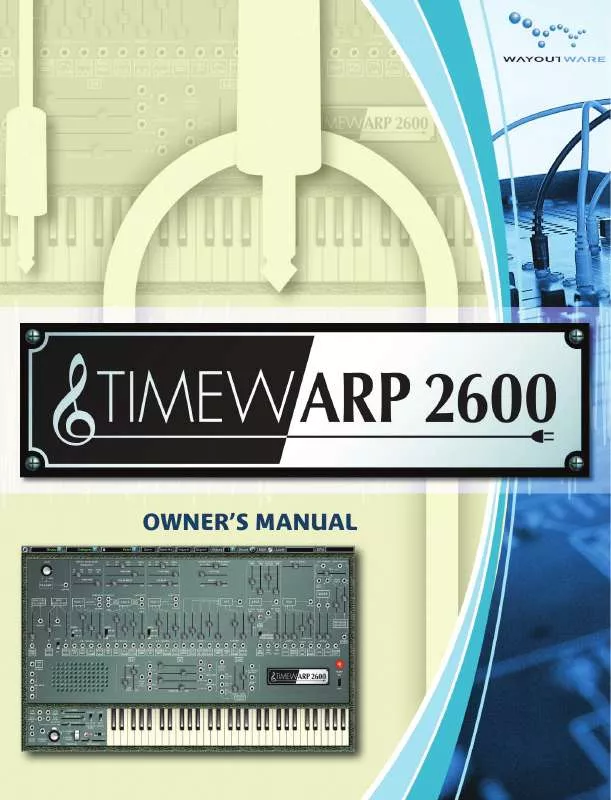Detailed instructions for use are in the User's Guide.
[. . . ] OWNER'S MANUAL
Owner's Manual
Copyright © 2004, by Way Out Ware, Inc. . No part of this work may be reproduced or transmitted in any form or by any means, electronic or mechanical, from or to any form of media, without the prior written permission of Way Out Ware, Inc. . Requests for permission to reproduce any part of this work should be addressed to : Way Out Ware, Inc. , attn: Copyright Adminstration, info@wayoutware. com.
Table of Contents
1
1 The ARP 2600, 1970 1981 and onward. . . 1 2 System Requirements, Installation, Configuration, Setup and Usage . [. . . ] What happens when we modulate its frequency?Clearly, since the signal that results from AM or FM methods is no longer a plain vanilla sine wave, then, in the frequency domain, it must have some additional components. These additional components are called sidebands. They have been studied for at least a century, and are pretty well understood physically and mathematically. Audio synthesis is probably the only application of AM or FM modulation where we are interested in sidebands for their own sake, as something to listen to directly; in the past, this stuff was only interesting to radio engineers, radar, sonar, television broadcast engineering. In those disciplines, modulation sidebands are products of broadcasting methods, in the electromagnetic spectrum. Because of that historical background, some of the conventional language for talking about modulation processes is a little weird: the signal being modulated is often referred to as the carrier signal, and the signal that signal provides the modulation pattern is called the program. (Guess why. )
Given this for a carrier: carrier spectrum
. and this for a program program spectrum
here's the AM result: lower sideband
carrier weakend upper sideband
Any form of modulation generates, for each component of the original signal, at least one lower sideband at a frequency equal to the component minus the modulating frequency and at least one upper sideband, at a frequency equal to the component plus the modulating frequency. If the carrier the original signal - is itself complex, with multiple spectral components, then each of its components will produce its own sidebands independently of all the others. Likewise, if the modulating signal the program - is complex, the arithmetic applies separately to each of its components. So, just for example, if you modulate a 10-component carrier signal with a 10-component program signal, the signal resulting from the modulation will have not less than 100 spectral components. This can get very messy; the most useful thing you can do with such a signal, before you do anything else, is filter it to get rid of some of the fuzz.
here's the ring modulation: the carrier is gone ?
and here's the FM result:
variable number of sidebands
and varying amplitude depending on the modulation depth
3. 6. 5. 2
Amplitude Modulation Suppose we modulate the amplitude of a 1000Hz sine wave with a 5Hz sine wave. The result is indistinguishable from what we would get if we mixed three sine waves, at 995Hz, 1KHz, and 1005Hz. The 995Hz component of the output is the lower sideband resulting from the modulation, and the 1005Hz component is the upper sideband.
24
CHAPTER 3 - The Craft of audio Synthesis 3. 6. 5. 2. 1 Ring Modulation Whereas a VCA responds only to a positive-going signal at its amplitude-control input, a ring modulator responds to both positive and negative levels at both of its inputs. Its output is simply the product, arithmetically, of the two inputs. If you are new to audio synthesis, draw a couple of signal graphs it doesn't matter what they are on the same timebase and vertical scale, and use a pocket calculator to work out the result of multiplying the two signals together. (The expression "ring modulator" describes the appearance of the analogue circuit design that's required for the multiplication. ) In the frequency domain, the difference between this and ordinary AM is only that the carrier signal components are suppressed. Once again, if you work out the arithmetic, a single-frequency carrier, modulated by a single-component program, generates a threecomponent AM spectrum but only a two-component ring-modulation spectrum. Well, since the carrier is almost always periodic (it comes from an oscillator, right?), it has a harmonic spectrum. Suppressing this spectrum lets you hear just the sidebands, which can be completely enharmonic if you're careful about the ratio of the two input signal frequencies. 3. 6. 5. 2. 2 Frequency Shifting It's theoretically possible not only to suppress the original carrier, as in ring modulation, but to isolate the lower and upper sidebands and make them available separately. [. . . ] The low C on a standard 5 octave keyboard acts as the root note (55Hz), and the harmonics play upwards from there. The remaining keys above and below the 5 octave range are filled with the same intervals as Carlos' Harmonic 12 Tone that follows.
6. 1. 3
Carlos Harmonic Twelve Tone Wendy Carlos' twelve note scale based on octave-repeating harmonics. 1/1 17/16 9/8 19/16 5/4 21/16 11/8 3/2 13/8 27/16 7/4 15/8
6. 1. 4
Meantone Temperament An early tempered tuning, with better thirds than 12ET. Use this to add an authentic touch to performances of early Baroque music. [. . . ]


 WAY OUT WARE TIMEWARP 2600 PATCH MANUAL (117 ko)
WAY OUT WARE TIMEWARP 2600 PATCH MANUAL (117 ko)
 WAY OUT WARE TIMEWARP 2600 PATCH TUTORIAL (117 ko)
WAY OUT WARE TIMEWARP 2600 PATCH TUTORIAL (117 ko)
